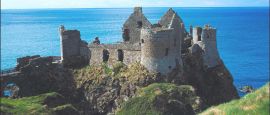Northern Ireland Weather, climate and geography
Weather & climate
In general, the weather is similar to the rest of the UK, but Northern Ireland tends to have less sunshine and more rain. The hilly nature of the terrain tends to attract clouds, and westerly winds are common in some areas. Extremes of temperature are rare but conditions can be changeable. In broad terms, however, it has an equable climate – the effects of the Atlantic Gulf Stream have a moderating influence, leading to mild winters and relatively cool summers. The mean annual temperature in Northern Ireland at low-lying altitude is around 9°C.
The height of summer draws the largest numbers of tourists, particularly to headline attractions such as Giant’s Causeway, so it can be advisable to come in spring or autumn to make the most of the reduction in visitors.
Similar to the rest of the UK, according to season. Waterproofs are advisable throughout the year. If you find yourself lacking any vital wardrobe items on arrival – formal or informal – all key towns and cities are well stocked with clothing outlets, with the larger cities particularly good in terms of picking up high quality outdoor equipment. Camping essentials are also straightforward to come by.
Geography
Northern Ireland contains some beautiful scenery, from the rugged coastline in the north and northeast to the gentle fruit-growing regions of Armagh. To the west are the Sperrin Mountains and the lakelands of Fermanagh, where the winding River Erne provides excellent fishing.
The high moorland plateau of Antrim in the east gives way to the glens further south and to the Drumlin country of County Down; further south still, the Mountains of Mourne stretch down to the sea.
The country comprises six historic counties: County Antrim, County Armagh, County Down, County Fermanagh, County Derry/Londonderry and County Tyrone. Northern Ireland is still sometimes spoken about as Ulster, despite the fact that it includes only six of the nine counties that comprised the historic Irish province (the other three are across the border in the Irish Republic).
Belfast sits in the east of the country, at the point where the River Lagan reaches the sea. This strategic location, being easily accessible from various parts of the UK mainland, was integral to its heritage as a major shipbuilding destination. The hills around the city, which some claim resemble a sleeping giant, are said to be the inspiration for Jonathan Swift’s classic novel Gulliver’s Travels.
Do you have any Feedback about this page?
© 2025 Columbus Travel Media Ltd. All rights reserved. No part of this site may be reproduced without our written permission, click here for information on Columbus Content Solutions.




 You know where
You know where